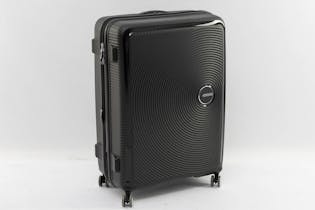Luggage
We’ve tested a range of large and small suitcases to see which are most durable and easiest to use.
If you’re a regular traveller, you need luggage that lasts. But some suitcases won’t go the distance. And some small cases don’t meet airline carry-on criteria.
Types of luggage
Large cases (check in)
Weight and size restrictions for check-in luggage vary between airlines and sometimes depend on the fare purchased or where you’re travelling.
Many airlines flying into and out of New Zealand allow cases up to 23kg and 158cm (combined dimensions) for economy class fares before you’ll be asked to pay an oversized baggage fee.
Some airlines allow larger and heavier luggage, but Emirates limits each case to 20kg for certain fare types and to 150cm (combined dimensions) for flights to and from the Americas or Africa.
Small cases (carry on)
Carry-on bags (also called cabin luggage) typically can’t exceed 7kg. But the size limits vary between airlines. Despite being sold as carry-on bags, many small cases don’t meet the size criteria for Jetstar, Qantas, Virgin Australia, Emirates or Singapore Airlines. For this reason, our test results refer to large and small cases rather than check-in and carry-on bags.
The small cases we’ve tested weigh 1.6–2.7kg. The heavier ones don’t allow much for your belongings before reaching the 7kg carry-on limit. We packed a small case weighing 2.4kg for a typical weekend away. The load didn’t completely fill it, yet it weighed 8.3kg.
If you pack one of these carry-on cases to capacity, you’re likely to exceed the weight limit and need to check it in, even if it meets the airline’s size criteria. And, if you’re asked to check in your oversized or overweight carry-on case at the boarding gate, you’ll have to pay.
It’s cheaper to pre-book a checked bag before you get to the airport if you think you might exceed your carry-on allowance.
Luggage features
Consider the following features when buying luggage for your travels:
-
Size: The size of a suitcase, as it relates to airline baggage allowances, is the total of its height + width + depth in centimetres. But manufacturers don’t always include wheels and handles in their measurements.
We accurately measure the size of each suitcase in our test. If you’re choosing a luggage in person, use a measuring tape and include any protruding handles and wheels when measuring.
Body type (hard or soft shell): Hard-shell cases provide more protection, while soft-shell models are typically lighter. Hard-shell cases usually open into two halves, which can be awkward when both sides are fully packed. Soft-shell models usually open on one side.
Zips: Look for high-quality recessed or protected zips. Exposed zips can get damaged and fail.
Zip locks: Most cases either have zips with a padlock hole or a built-in TSA combination lock on the main compartment. Check our test results to see which models have both. A TSA lock allows security to open your suitcase without causing damage or destroying the lock.
External pockets: They’re handy for quick access items. Usually, soft-shell cases have external pockets and hard-shell models don’t. Make sure the zips can be locked.
Weight: The weight of your suitcase counts towards your baggage allowance. You won’t be able to pack as much in a heavier case before reaching the weight limit. We accurately weigh each case in our test.
Internal volume: Wheels and extendable handles take up some internal space, so look inside the case to make sure it has enough volume for your gear.
Expandability: Some suitcases can be expanded by unzipping a section. This can be useful for extra items bought on your travels, but the extra fabric and zip add weight. And you’ll need to check that expanding the case doesn’t make it exceed baggage limits.
-
Wheels: You can push a case with four spinner wheels on all four wheels or pull it behind you by leaning it onto two wheels. Four-wheeled cases are easier to move around than models with two fixed wheels. But some can be difficult to control over bumpy terrain and they can roll away on a slope.
Two-wheeled models only move forwards and backwards but they’re usually better at clearing kerbs and rolling on uneven surfaces. And they won’t roll away on their own.
Extendable handle: Look for one that locks into a position suitable for your height and check it has a comfortable grip. The lock/release button should be easy to use one-handed.
Side handles: Most suitcases have a fixed handle on top and usually a side handle too. Side handles make a case easier to lift and carry. Check our test results to see which models have a side handle.
Internal straps: These will help secure loads in a partly filled case. Each half of a hard-shell case usually has a zipped cover to keep contents in place.
We've tested 15 suitcases.
Find the right one for you.

.jpg&w=315&q=75)
.jpg&w=315&q=75)